[Toward the end of September 2021 I received an email from one Dr. Dennis Low, a London-based photographer and researcher on the niche subject of historic zoo photography, theretofore unknown to me — and, apparently, vice-versa.
Dr. Low contacted me because I serve on the advisory board of the European Society for the History of Photography (ESHPh), with which he found himself in contention over an article recently published in its semiannual journal, PhotoResearcher. Said article concerns a major uproar in the U.K. photo scene, involving censorship, “cancellation,” and charges of racism. Finding himself referred to gratuitously in that report, thus implicated in it, yet in serious disagreement with its methodology and conclusions, Dr. Low had drafted an extensive response thereto, which the ESHPh had refused to publish. Given my connection to the organization, he asked, how would I suggest he proceed?

ESHPh logo
After perusing the relevant materials, I concluded that I could best serve the interests of Dr. Low (whose right to argue his case in a public forum I respect), the ESHPh (whose print journal and website do not easily adapt to lengthy disputation and the exchange of opinion), and what we perhaps too loosely refer to as “the discourse” on photography by making space available here at Photocritic International for him to present his argument in full. I should add that I do so on my own initiative, without consulting the ESHPh. I believe this blog’s readers will find it as relevant and fascinating as I do.
To be clear, I have no stake in this dispute. I have no involvement in the editing of this journal, whose board did not consult with me on the publication of the Neumüller article; I have not seen the book in question; and I have no personal or professional relation to any of the principals and other organizations involved. (Full disclosure: In 2010 I received the J Dudley Johnston Award for “lifetime achievement in writing about photography” from the UK’s Royal Photographic Society, which has a peripheral connection to this situation, as discussed in a later segment.)
I do not intend publication of Dr. Low’s paper here as either an endorsement of his position or a rebuke to the ESHPh. I intend only to make possible a debate over the issues he raises and his positions thereon, which I consider legitimate, well-reasoned, and supported by his documentation. (Click here to download a PDF of the original article to which he responds.)
Due to its length, I have divided Dr. Low’s paper into installments, for easier absorption online. Click here for part 2, here for part 3, here for part 4, and here for part 5. When the series concludes, a PDF download of the complete article will become available.
As always, I welcome comments; and, as always, these will get moderated, with ad hominem attacks, trolling, and anonymous/pseudonymous entries automatically discarded. — A.D.C.]
•
A Note from the Author

Dennis Low, selfie, 2022
My name is Dr Dennis Low. I’m a fine artist, based in London, with a research-based photographic practice that explores the relationships between humans and animals. In 2016, I received a grant from Artquest, a U.K.-based non-profit, to photograph British zoos.
I’m an independent scholar, too, with research interests in the history of zoo photography specifically. In 2017, I published a long essay in Antennae (Vol. 40, 2017, free to download here) that broadly delineates this field. Currently, I’m writing an account of the changing cultural representation of gorillas from 1820 to the present day; and, also, a book-length study of various artists and writers of the nineteenth and twentieth centuries, all of whom made formative work in zoos.
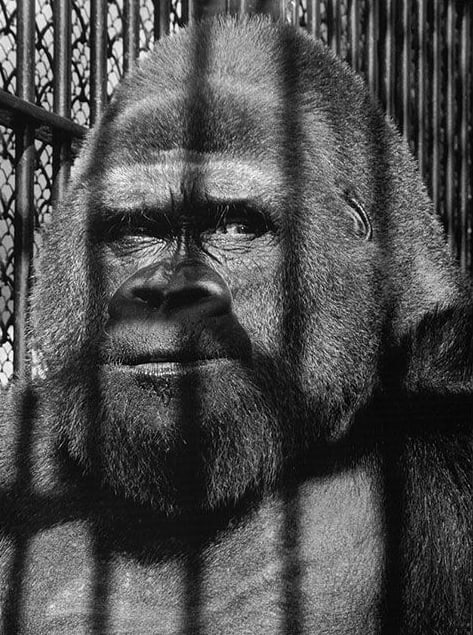
Wolfgang Suschitzky, Guy the Gorilla, 1958
I first came across Gian Butturini’s London (1969) in one of Tom Seymour’s articles for The Art Newspaper. I was immediately struck by just how good a zoo photograph Butturini’s gorilla portrait was. To me, it read like a gritty, Provoke-style, cool-cat take on Wolfgang Suschitzky’s “Guy the Gorilla, London Zoo” (1958), which was widely disseminated in its time and also used by the Born Free Foundation in one of their earliest anti-zoo campaigns. Butturini’s photograph, as it happens, is of that exact same gorilla, a decade on, still adored by the great British public, still stuck in that cage.
I saw the female ticket inspector, too, exhausted in her London Underground booth. We still have those booths in London, today: they continue to be about the same size, but, thankfully, offer a bit more warmth and shelter for the keyworkers who staff them, essential in these on-going times of Covid. What I didn’t see was racism.
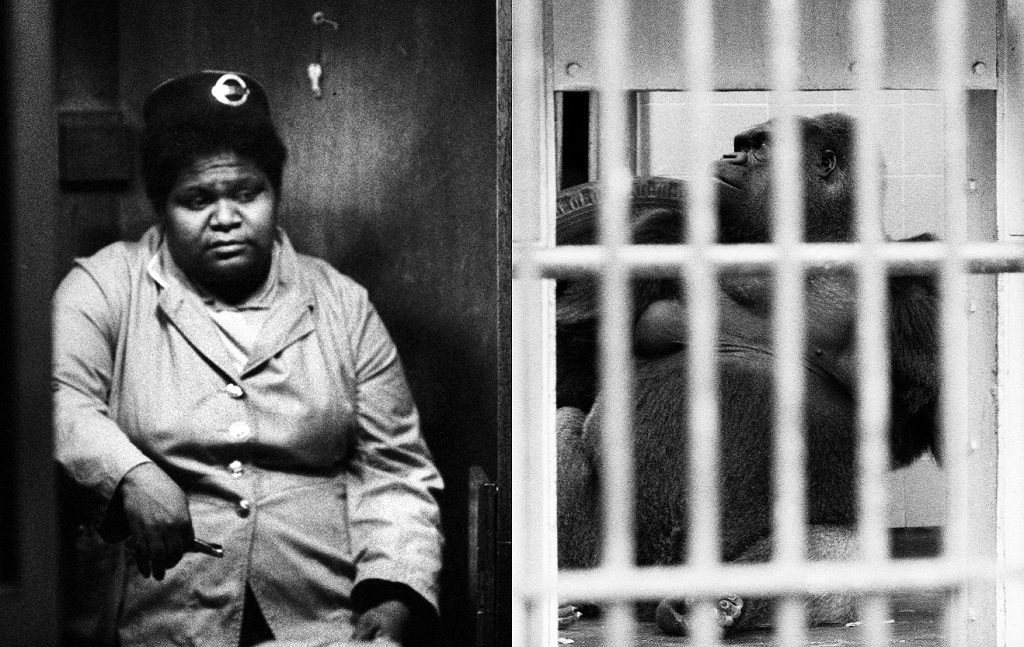
Gian Butturini, London (1969), spread
And neither did the book itself, which I bought as it was withdrawn from market, read as racist to me. On the page before, there’s a little East Asian baby in a pram: with a different roll of the dice, he could have so easily been one of ‘1/4 million killed – 3/4 million burned and wounded children in Vietnam’ mentioned on the banner that leads the protest in the image placed above him. On another page, there’s a portrait of a man, smiling though he has seen too much, with an Israeli flag pinned to his lapel; he’s placed next to a stark graphic of barbed wire, that speaks of the atrocity from which that nation-state was carved.
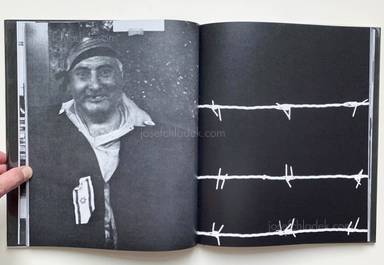
Gian Butturini, London (1969), spread
These pairings clearly participate within a long-standing, distinctly socialist tradition of photographic juxtaposition, used to great effect, to take just one example, by Suschitzky’s elder sister, Edith Tudor-Hart. Earnest? Yes. Politically urgent? For sure. A Romantic, cosmopolitan citizen of the world? Absolutely. A racist? Surely not, not with these always beautiful, always sensitive photos, upon whose publication Butturini would throw in his successful career as a graphic designer, so he could devote the rest of his working life to documentary photography and the plight of the oppressed.
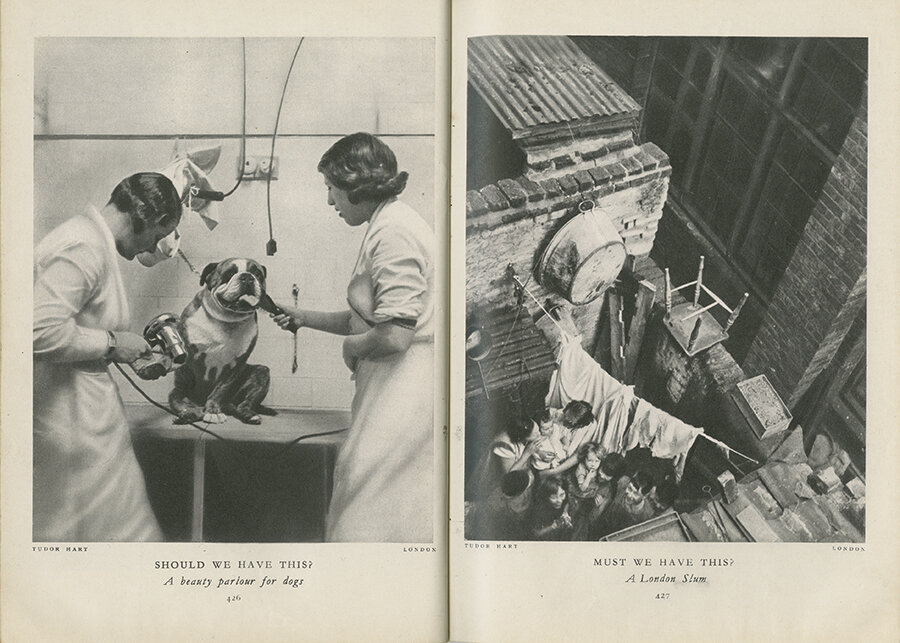
Edith Tudor Hart, from Lilliput Magazine, 1939
•
It’s with these half-formed thoughts that I logged onto Twitter, hoping to find some clarity, perhaps some choice quotations so far unused by the media, with a long-range view to using the Butturini story as a narrative touchstone for my own, more general thoughts about the changing cultural representation of gorillas across the nineteenth and twentieth centuries. Instead of finding quick answers, I inadvertently stumbled across another story, one of dizzying complexity in which the live concerns of contemporary identity politics were being co-opted and exploited, carefully and cynically pressed into the service of personal ambition.
![]() Counter to its stated aims, Moritz Neumüller’s article knowingly suppresses that story; and, upon realising that the story would simply be lost if I elected to remain silent, I penned this reply. Once complete, it was sent to Uwe Schögl, Executive President of the European Society for the History of Photography (ESHPh) and editor of PhotoResearcher, with a view to publication therein:
Counter to its stated aims, Moritz Neumüller’s article knowingly suppresses that story; and, upon realising that the story would simply be lost if I elected to remain silent, I penned this reply. Once complete, it was sent to Uwe Schögl, Executive President of the European Society for the History of Photography (ESHPh) and editor of PhotoResearcher, with a view to publication therein:
Email from Dennis Low to Mag. Uwe Schögl and PhotoResearcher Editorial Board, 28 July 2021
Dear Uwe Schögl and Photoresearcher Editors
I’ve been in correspondence with Prof. Liz Wells who has given me this address and informs me that you may have missed my previous emails, so allow me to begin again from the top.
You may recall my writing to you in February. Moritz Neumuller had requested that I write to you directly, and, regrettably, I had to withhold my permission to use my interview transcript in his article, on the basis that pertinent information had been redacted from it.
Hoping for the best, but fearing for the worst, I read Mr Neumuller’s finished article in your last issue with interest. My concerns were not unfounded. What I read was replete with numerous factual errors, historical inaccuracies, and deliberate obfuscations which, I think you will discover, fall way short of PhotoResearcher’s rigorous academic standards.
I have recently had the opportunity to write a reply [to] Mr Neumuller’s article, detailing these faults and its academic dishonesty, and wondered whether I might send it to you, with a view to publication in your journal? It seems fitting to offer first refusal to PhotoResearcher given their role in disseminating Neumuller’s inaccurate information in the first instance.
Kind regards
Dr Dennis Low
•
In due course, Schögl rejected my paper, writing (in part):
… We consider well-founded source analysis, methodological transparency and reflection, argumentative coherence, and balance vital in this connection. The four-person editorial team, of which I am a member, feels that these requirements were fulfilled in an exemplary fashion in Mr Neumüller’s essay.
However, to our surprise, your text, which is so emphatically written, includes an entire arsenal of allegations and objections that we do not feel to be viable and valid. …
(Excerpt, email from Uwe Schögl to Dennis Low, 16 September 2021.)
The charges levied at me were, I felt, entirely spurious. But what I particularly objected to, as I’d explain to Danube University Krems where Schögl works as Senior Lecturer, was that Neumüller himself had been included in this review process. Danube University Krems duly forwarded my grievances to the Austrian Agency for Research Integrity (OeAWI) for resolution. [Note: A passage that may have inadvertently breached confidentiality has been removed as of 3/3/22. — Ed.]
•
Thankfully, Mr Coleman holds an entirely different opinion from that of Schögl and his editorial team at PhotoResearcher. I am most grateful to him for this opportunity to finally bring the hitherto untold story of the Butturini-Parr scandal to light.
•
A Reply to Moritz Neumüller’s ‘”A Stone Thrown At My Head”:
London by Gian Butturini — A Reception History, 1969-2021′ (a)
by Dennis Low
A year on, and it seemed like a fresh sense of perspective was needed. Following a well-timed and, ultimately, decisive social media campaign against Gian Butturini’s London (1969), the Italian art publisher, Damiani, had withdrawn their 2017 facsimile edition from sale; and the celebrated British photographer, Martin Parr, who’d written its new introduction, had issued a public apology and stepped down as director of the newly minted Bristol Photo Festival.
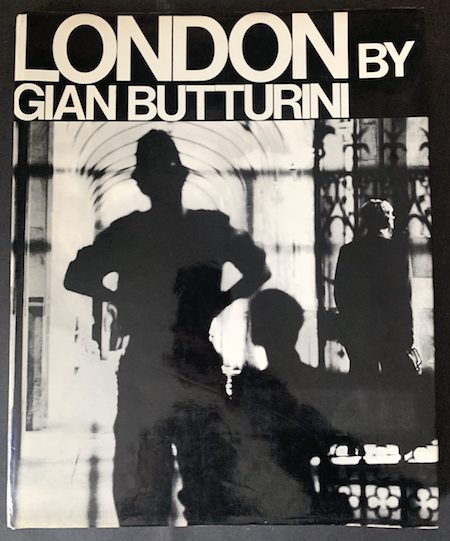
Gian Butturini, London (1969), cover
It was, believed photography curator and writer, Moritz Neumüller, high time for an impartial and balanced reassessment of the events that had occurred. His editors at PhotoResearcher anticipated a ‘profound analysis of the sources’ (2021, p.5) while Neumüller would, he himself maintained, be ‘[a]s an author in the scientific context’, promising ‘a comprehensive analysis’; ‘a full historic perspective’; and ‘an academic discourse that will enable a critical breakdown of the facts’ (2021, p.137)[1].
At its best, Neumüller’s long article, ‘“A Stone Thrown at My Head”. London by Gian Butturini – A Reception History, 1969-2021’, delivers on some of those promises. His section on the ‘physis and access’ of the book, that presents an inventory of the differences between the first edition and the facsimile, is, indeed, ‘the driest and most technical description of the book’ (2021, p.139). The original is 3cm taller and wider than the facsimile, and an extra 0.5cm thick on account of a differing paper weight. The facsimile loses a Robert Capa quotation from the endpaper; and a removable white or yellow bellyband.
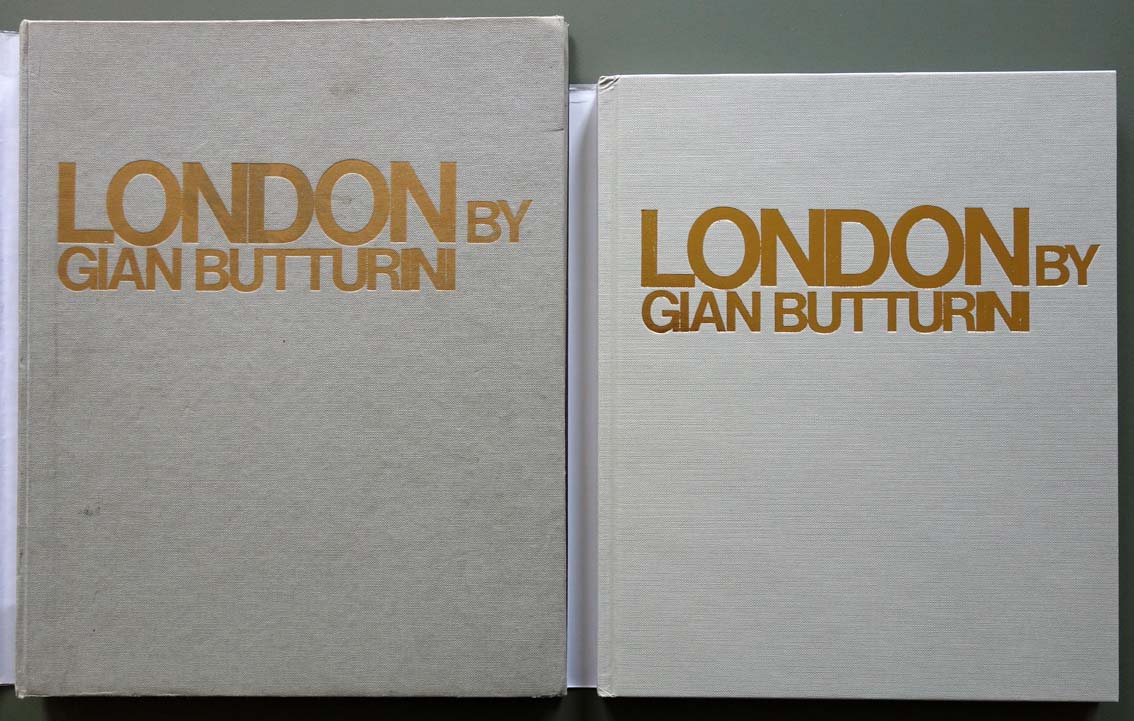
Gian Butturini, London: (l) 1969 edition, (r) 2017 edition, covers
•
The overall impression, given here, is one of professional competence, and the article’s extensive textual apparatus, which runs to 22 illustrations and 95 footnotes over just 31 pages, lends its exhaustive gravitas to a forensic veneer, one carefully designed to give the impression that this must be a study in which no stone has been left unturned.
And, yet, this apparatus soon begins to unravel. In the opening paragraph, Neumüller contends that Butturini took the photographs for London in June 1969 (2021, p.135) and, in doing so, contradicts Michele Smargiassi, an important secondary source whom he references on three occasions, who asserts the photographs were made in 1968.[2] A footnote is vital, here, but there’s no reference to document Neumüller’s alternative date. At first glance, this seems a trivial, hair-splitting point of order, but whether the photographs were made before or after Enoch Powell’s infamous ‘Rivers of Blood’ speech in April 1968 surely makes all the difference in a case as sensitive as this.
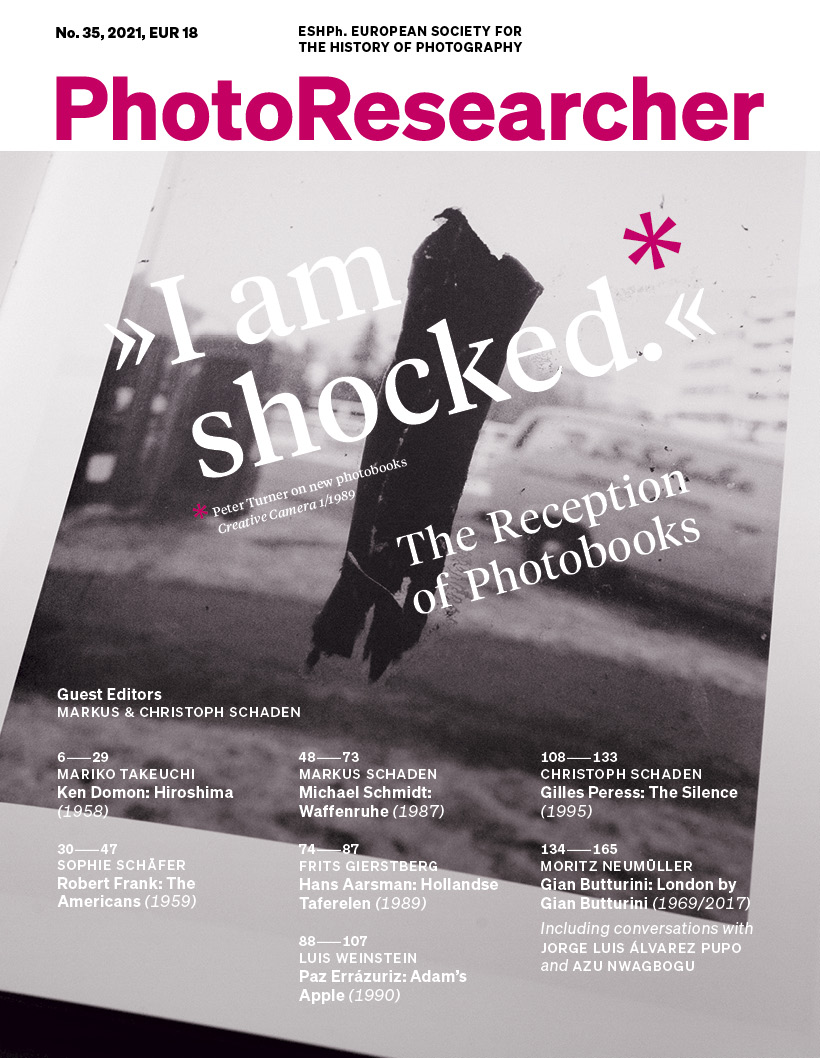
PhotoResearcher, Issue 35 (2021), cover
A few pages later, after quoting an interesting contemporaneous review that reads Butturini’s gorilla as an anti-racist provocation, Neumüller argues that ‘This does not mean, of course, that other readers and the author himself were not aware of the racist trope’ (2021, p.141). This time, he adds a footnote for good measure, referencing Livingstone Smith and Panaitiu’s ‘Aping the human essence’ (2016) essay. [Click here for free PDF download of this essay.]
Not only is it never made clear why this essay is referenced, but Neumüller seems unaware that this essay – like the rest of the volume in which it is published – takes pains to note the geographical and historical specificity of racist tropes and carefully acknowledges, too, its own, specific ‘emphasis on the North American context’[3]. On a third page, the footnote is plainly wrong: the ninety-third footnote misattributes a quotation to the American photography journalist, Andrew Molitor, that, more properly, belongs to British photography graduate and blogger, Mick Yates (2021, p.165n).
Exuding an exhaustive scholarliness and an air of academic authority, Neumüller’s textual apparatus thus becomes unstable on close inspection, at its worst incomplete, misleading, and factually inaccurate. There is, however, a central and most inconvenient truth that lies at the very heart of last summer’s Parr-Butturini scandal, and Neumüller’s refusal to acknowledge that truth, or even entertain the possibility of its existence, cascades through his scholarship with devastating implications.
And that truth is this: Parr and Butturini’s social media detractors, very limited in number and audience, never put forward a case to support their claims that Butturini’s London was a racist text. ‘[I]t’s racist, right?’ Benjamin Chesterton would tell 10 Frames Per Second, half-wondering whether to discuss any alternative before deciding against it, ‘because — like, let’s not even to go there in trying to [unintelligible] with that discussion’[4].
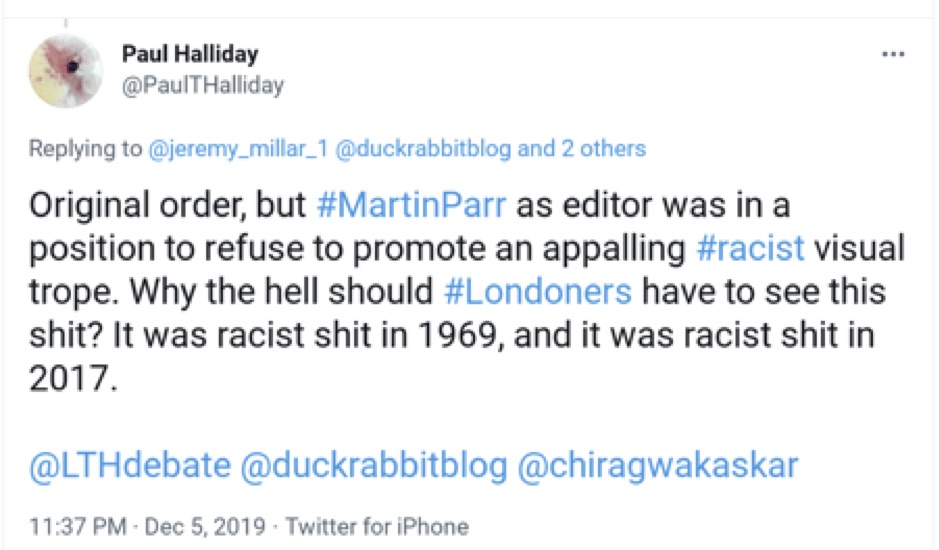
Paul Halliday, Butturini tweet, 12-5-19
On Twitter, Paul Halliday would assert that ‘It was racist shit in 1969, and it was racist shit in 2017’[5]; and that his teenage daughter, Mercedes Baptiste Halliday, ‘did her research’[6]. But this research, if it existed at all, never materialised, for scrutiny, consideration, discussion, or debate.
This distinct absence of argumentation, compounded by the blunt refusal of Paul Halliday, Mercedes Baptiste Halliday, and Benjamin Chesterton, to participate in interviews, thoroughly derails Neumüller’s overriding and stated ambition for a balanced, critical, even quasi-scientific appraisal of Butturini’s London and the subsequent scandal. Bewilderingly, in the stark absence of an actual case to précis, Neumüller’s only option is to manufacture that case himself.
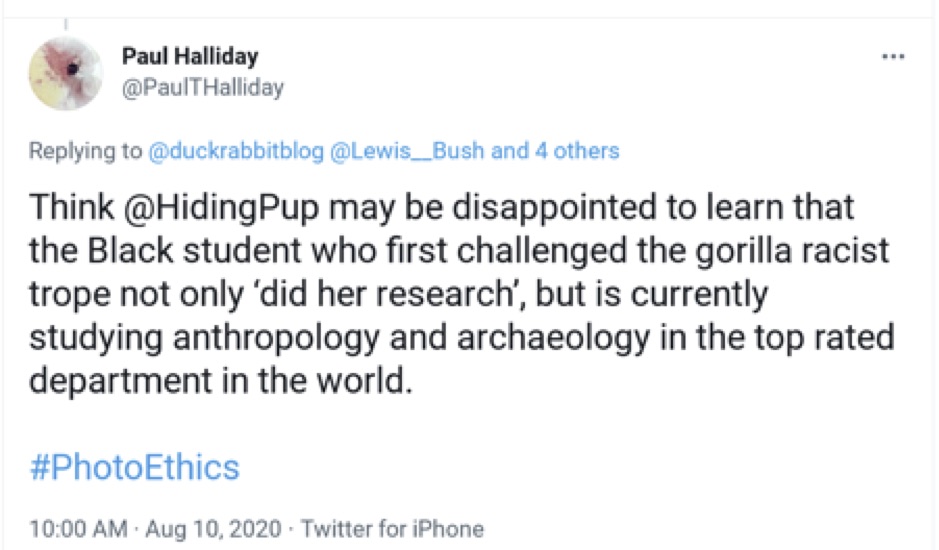
Paul Halliday, Butturini tweet, 8-10-20
Neumüller’s interviewees and allies seem to quickly rally behind the ill-fated conceit of his scientific objectivity. Belgium-based artist, Jorge Luis Álvarez Pupo, whom Neumüller, as festival curator, included in PhotoIreland in 2012[7], delivers a fake and baseless statistic: ‘I would dare to say that 95 % of black or colored people would be shocked’ (2021, p.150). Azu Nwagbogu, whom Neumüller had worked with on PhotoIreland’s New Irish Works project in 2016[8], offers similarly meaningless stats: ‘Out of one hundred people who see this image on the internet, ninety-five will say that it is completely abysmal and wrong’ (2021, p.163); ‘Racism was rife with lots of overt racism and tensions in society. Butturini was 100 % aware of this and the danger of aping blackness and its dehumanising effect’ (2021, p.162).
By way of emotional leverage, Pupo includes an anecdote about being racially abused by his late girlfriend’s toddler nephew, while Nwagbogu, more soberly, adds a thumbnail history of Britain’s Windrush generation, asserting that ‘The 1960s were probably the peak of the Windrush generation with a sudden influx of Afro-Caribbeans and others from Africa and the Commonwealth who came to work and earn a living in the United Kingdom’ (2021, p.162). Nwagbogu is apparently unaware of the Commonwealth Immigration Acts of 1962 and 1968 which severely curtailed work-related immigration from the Commonwealth, and, additionally, set up a difficult work voucher application as a requirement in the process.
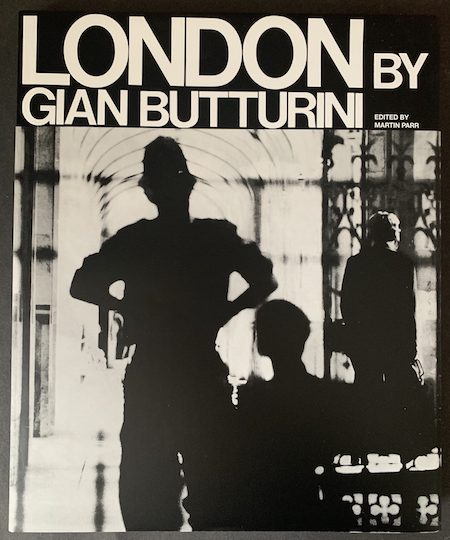
Gian Butturini, London (2017), cover
To this hodgepodge of invented, ‘scientific’ statistics, unrelated personal anecdote, and historical untruth that stands in for the absent argument of Butturini’s detractors, Neumüller adds his own, fanciful exaggerations. Needing to create, from scratch, an international stage for the debate, Neumüller disingenuously offers a rhetorical sleight of hand regarding the book’s distribution worldwide. ‘Today,’ he writes, ‘both versions of London by Gian Butturini are part of public library holdings, in the US, Italy, Germany, the UK, Sweden, and The Netherlands, but also as far away as Australia and Singapore’ (2021, p.140).
Worldcat, the world’s largest and single most comprehensive library catalogue, lists only one copy in Australia (RMIT University, Melbourne) and one in Singapore (Nanyang Technological University, Singapore). Just two copies of the book, each costing around €40, would, in Neumüller’s homeopathic estimation, enlarge the global territory for Butturini’s book by approximately 7.7 million square kilometres.
This wilful exaggeration is one that Neumüller knowingly executes, but he’s barely started. He knows that Damiani had been contracted to produce 2,000 copies of the book and had, as is common practice in the publishing industry, extended the actual print run to 2,200 copies (a final figure confirmed by their own documentation, held by the Butturini estate). He also knows that, upon publication, the Butturini estate had purchased 200 copies for their own use; and that, upon the book’s withdrawal from sale, 1,200 and 820 copies were returned to the Butturini estate from American and British warehouses respectively.[9]
Allowing for counting errors at every stage, the incontrovertible fact remains that the total number of copies sold, including the 40 library copies listed by Worldcat, was statistically insignificant. A quick calculation demonstrates that London was, for all the time it had been on the market, nothing short of an unmitigated commercial failure; and it’s perhaps for this reason that Damiani so readily acquiesced to the book’s withdrawal.[10]
These bottom-line ledger details, revealing as they are, go entirely ignored by Neumüller in favour of an undocumented, ‘estimated edition of […] 3,000’ (2021, p.139, my emphasis). This significantly higher number conjures approximately 740 imaginary copies of the book into existence, 740 paper apparitions to go forth into the world – not a huge number, to be sure, but better than none at all. In any event and, by now, somewhat incoherently, even Neumüller has to concede that, ‘Despite Martin Parr’s engagement, the new edition of London by Gian Butturini received only a modest amount of attention outside of Italy’ (2021, p.152). …
•
Notes:
[1] For ease of cross-referencing, references to Moritz Neumüller’s article have been inserted in the body of the text. For the full text of Neumuller’s article, see: M. Neumüller, ‘“A Stone Thrown at My Head”. London by Gian Butturini – A Reception History, 1969-2021’. PhotoResearcher (vol. 35, 2021), pp.134-165. It is also available as a free download at: <https://www.academia.edu/47744232/_A_Stone_Thrown_at_My_Head_London_by_Gian_Butturini_A_Reception_History_1969_2021?source=swp_share>.
[2] M. Smargiassi. (2020). Butturini razzista? Pensieri su un’occasione perduta. [online] Fotocrazia. Available at: https://smargiassi-michele.blogautore.repubblica.it/2020/09/30/gian-butturini-ondon-martin-parr-fotografia-razzismo-halliday/ [Accessed 30 Jun. 2021].
[3] D. L. Smith and I. Panaitiu. (2015). Aping the Human Essence: Simianization as Dehumanization. In Simianization, Apes, Gender, Class, and Race. Eds. W. D. Hund, C. W. Mill and S. Sebastiani. Zurich: LIT. p.77.
[4] 10fps.net. (2021). No. 72 Benjamin Chesterton – 10 Frames Per Second. [online] Available at: http://10fps.net/no-72-benjamin-chesterton/ [Accessed 12 Jul. 2021].
[5] Twitter. (2021). [online] Available at: https://twitter.com/PaulTHalliday/status/1202733658735566848 [Accessed 7 Jun. 2021].
[6] Twitter. (2021). [online] Available at: https://twitter.com/PaulTHalliday/status/1292747735624560645 [Accessed 7 Jun. 2021].
[7] PhotoIreland. (2012). PhotoIreland Festival 2012: Migrations 1-31 July. [online]. Available at: <http://2012.photoireland.org/wp-content/uploads/2012/05/PIF_2012_Catalogue.pdf>. [Accessed 7 Jun 2021].
[8] PhotoIreland. (2013). About New Irish Works – New Irish Works. [online] New Irish Works. Available at: https://newirishworks.com/about/ [Accessed 7 Jun. 2021].
[9] Email from Moritz Neumüller to Dennis Low, 9 January 2021.
[10] For a while, a brief notice on the Damiani website read: ‘In line with its ideals of tolerance, mutual respect and peaceful coexistence, Damiani has decided to suspend sales of Gian Butturini’s book “London” in order not to fuel controversy and manipulation with regard to the unfounded accusations of racism brought against Gian Butturini and Martin Parr.’ See: Damiani. (2020). London by Gian Butturini: suspended sales. [online] Available at: https://web.archive.org/web/20210116075117/https://www.damianieditore.com/en-US/blog/london_by_gian_butturini_suspended_sales [Accessed 30 Jun. 2021].
•
© Copyright 2021 by Dennis Low. All rights reserved. For reprint permissions, other usages, and questions, please contact the author: dennis(at)takemetothekittens(dot)com.






Leave a Comment